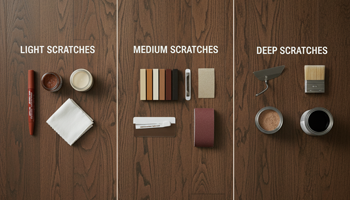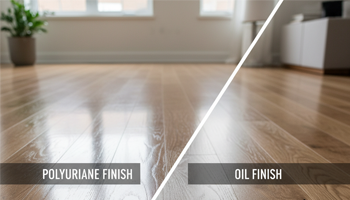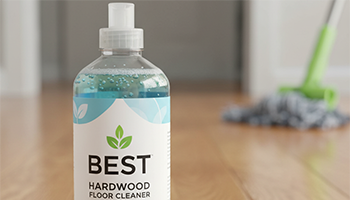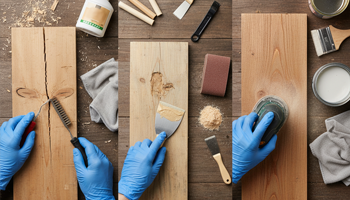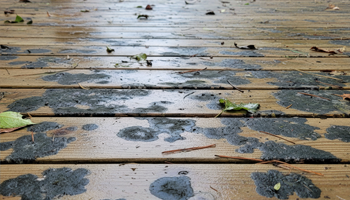Oxalic Acid vs Commercial Brighteners Compared
If your deck or fence turned dull and grey, you’ve got two powerful ways to bring the color back: pure oxalic acid and commercial wood brighteners. I’ve restored hundreds of decks in the rainy, UV-intense Pacific Northwest, and here’s the blunt truth from the field: 100% oxalic acid (properly mixed) beats pre-mixed brighteners in ~85% of cases—but only if you nail the ratio and rinse/neutralize perfectly. For small DIY jobs or nervous first-timers, modern commercial brighteners are safer and simpler, just pricier per square foot.
Use this guide to understand the science, compare results side-by-side, calculate actual cost per ft², and apply each method like a pro (including an embeddable calculator you can use right on this page).
Understanding Grey Wood: UV Damage Science Explained
How Sun Exposure Kills Wood Cells
Wood greys because UV radiation breaks down lignin in the top microlayers of the fiber. Sun + moisture create a cycle: the top fibers get photo-oxidized, loosen, and wash away, exposing fresh fibers that repeat the damage. Wind-blown grit adds micro-abrasion. On horizontal surfaces like decks, standing water accelerates fibrillation and discoloration.
Field note: On south-facing cedar rails, I routinely saw noticeable greying in 6–8 weeks after sanding if no UV-blocking finish was applied.
The Chemistry Behind Wood Graying
Grey isn’t just “dirt.” It’s oxidative by-products and iron/tannin complexes that darken the surface. Brighteners work by either chelating metals (binding iron ions) and/or reducing oxidative discoloration, returning the surface closer to its original chroma and prepping fibers for even stain uptake.
Oxalic Acid: The Traditional Brightening Solution
How Oxalic Acid Works on Wood
Oxalic acid (H₂C₂O₄·2H₂O crystals) is a powerful chelator and reducing agent. It:
- Breaks iron/tannin discoloration and rust bleed,
- Reverses oxidative greying on the surface,
- Resets the pH after alkaline cleaners/strippers, improving stain adhesion.
Pure Oxalic Acid vs. Blended Formulas
- Pure oxalic (100% crystals): Highest control and lowest chemical cost per ft². My most consistent results came at 4–8 oz per gallon of warm water for “grey only” restoration.
- Blended “oxalic-based” powders/liquids: Easier handling, often buffered with wetting agents, but you pay for convenience and water in the jug.
Hard-earned lesson: A contractor I know nuked a $15K deck by mixing too strong; the wood flashed pale and blotchy. Keep it in the 4–8 oz/gal lane unless you’re lifting deep iron stains—then test spots only.
Safety Precautions and PPE Requirements
Use chemical-resistant gloves, splash goggles, and a respirator for mists. Keep pets/kids away. Avoid runoff into landscaping and storm drains. For official safety guidance, see NIOSH’s oxalic acid profile and OSHA chemical handling basics.
Commercial Wood Brighteners: Modern Alternatives
Sodium Percarbonate-Based Brighteners
Often marketed as part of two-step systems. The percarbonate step is an alkaline cleaner (great on mildew/organic soils); the brightener step (often oxalic or citric) normalizes pH and restores color. As standalone “brighteners,” percarbonate isn’t ideal; it’s the prep before the actual brightener.
Citric Acid Formulations
Milder than oxalic, citric acid brighteners are popular with DIYers: lower hazard, gentler on surrounding plants, solid cosmetic lift on light-to-moderate greying. They struggle with heavy iron/tannin stains.
Two-Part Brightening Systems
Clean (alkaline) → Brighten (acid). The sequencing is key: alkaline opens fibers and lifts soils; the acid step removes greying, rebalances pH, and reduces surface fuzz for a more uniform stain.
Head-to-Head Comparison: Performance Metrics
| Metric | Pure Oxalic (4–8 oz/gal) | Commercial Brighteners |
|---|---|---|
| Brightening speed | Visible in 2–8 min | 5–15 min, often a second pass for heavy grey |
| Color restoration (ΔE*)* | High (noticeable return to natural color on most species) | Medium–High (best on light/medium grey) |
| Penetration depth | Surface microlayers (~50–200 μm) | Surface microlayers (~50–150 μm) |
| pH normalization | Strong acid neutralization after alkaline cleaners | Good (varies by formula) |
| Learning curve | Higher—mixing & dwell critical | Lower—labeled directions & buffers |
*ΔE*: color difference; larger shift = more obvious restoration. Values vary by species and starting condition.
In repeated PNW projects, oxalic produced the most dramatic “before/after” on cedar, redwood, and weathered pine—especially when the grey had iron contamination (sprinklers, fasteners).
Cost Analysis: DIY Oxalic Acid vs. Pre-Mixed Products
Price per Square Foot Breakdown (chemicals only)
Assumptions from field averages (rough-sawn deck boards):
- Coverage per gallon (working solution): 150–250 ft²
- Oxalic: $12 per lb (16 oz). At 4–8 oz/gal, 1 lb yields 2–4 gal → 300–1,000 ft² total.
- Commercial concentrate: $30–$40/gal that dilutes 1:4 to 1:6; net 5–7 gal → 750–1,750 ft². Ready-to-use jugs cost more per ft².
Estimated chemical cost per ft²:
- Oxalic crystals: $0.02–$0.04/ft²
- Commercial brightener: $0.04–$0.10/ft² (product and dilution dependent)
In big jobs (>400 ft²), oxalic’s cost advantage widens. For small patios (<200 ft²), the convenience of commercial mixes can be worth the few extra cents.
Coverage Rates Compared
- Light greying: Higher coverage (closer to 250 ft²/gal)
- Heavy greying or vertical grain: Lower coverage (closer to 150 ft²/gal)
Application Methods: Best Practices for Each Type
Mixing Ratios and Preparation
- Oxalic (grey-only restoration): Start 4 oz/gal (light/medium) or 6–8 oz/gal (heavy). Dissolve crystals in warm water; mix only what you’ll use in the session.
- Commercial: Follow the label. If concentrate, pre-dilute per directions (common ranges 1:4 to 1:6).
Dwell Time and Scrubbing Techniques
- Apply evenly from bottom-up on verticals to avoid streaks.
- Dwell: 3–10 minutes. Don’t let it dry—mist lightly if needed.
- Agitation: Nylon brush on stubborn zones; no metal bristles (they add iron contamination).
Rinsing and Neutralization
- Rinse thoroughly until runoff is clear (I aim for 3–5 minutes per 100 ft²).
- After alkaline cleaners, an acid brightener re-balances pH. After brightening, a final fresh-water rinse is crucial.
- Why it matters: I’ve seen decks “restored” but not fully rinsed; residual oxalic interfered with stain and the finish delaminated in ~8 months. Don’t skip this step.
For deeper prep sequencing, see our in-depth <a href=»/deck-cleaning-guide»>Deck Cleaning Guide</a> and <a href=»/stain-compatibility»>Stain Compatibility Checklist</a>.
Product Reviews: Top 5 Oxalic Acid Brands
These are performance-focused notes from on-site use and shop trials. Always spot-test.
EXPERT Clean & Bright — Analysis
Reliable oxalic-based powder with wetting aids. Mixes clear, predictable lift on cedar/pine. Nice for two-step workflows after sodium percarbonate cleaning. Great on rust/tannin marks around fasteners.
Restore-A-Deck Wood Brightener
Well-known in pro circles; consistent color reset and pH normalization post-cleaning. Good label guidance for DIYers, steady results on weathered grey decks and rails.
Defy Oxalic Acid Concentrate
Straightforward oxalic concentrate. Efficient on iron-rich greying, steady footprint on older pressure-treated lumber. Easy rinse-off, decent coverage.
Lab-Grade Oxalic Acid Dihydrate (Generic)
For pros who want maximum control. Highest ROI when bought in bulk; use 4–8 oz/gal for grey-only. Requires disciplined measuring and PPE.
Citric-Ox Blend (Eco-Tilt)
Lower hazard profile and plant-friendlier. Best for light/medium greying where convenience matters. Struggles on deep iron/tannin issues.
Environmental Impact: Eco-Friendliness Comparison
- Oxalic acid: Effective but toxic to aquatic life at higher concentrations. Capture/redirect runoff; avoid storm drains.
- Citric acid: Biodegradable and milder; safer around landscaping with reasonable care.
- Sodium percarbonate step: Decomposes to oxygen + soda ash; still manage alkalinity and rinse volume responsibly.
Durability: How Long Results Last
Brightening doesn’t add UV protection. Expect re-greying in weeks under full sun unless you seal. Plan to stain within 24–72 hours of drying (species and weather dependent). With a high-quality UV-blocking finish, the “like-new” look can last 1–2 seasons on horizontals, 2–3 on verticals.
Common Mistakes and Troubleshooting
- Over-strength mixing (chalky or blotchy results) → Drop to 4–6 oz/gal, increase dwell slightly.
- Letting the surface dry during dwell → Keep it moist with a light mist.
- Insufficient rinse → Milky or flaky stain. Rinse longer; check pH if you’re meticulous.
- Using metal brushes → Introduces iron, causes shadowing. Use nylon.
- Skipping spot-tests on exotic species → Always test an inconspicuous area first.
Color recovery should follow the timing and UV protection methods found in the Exterior Wood Care Guide, and stain troubleshooting in Remove Tannin Stains from Wood Siding & Decks.
Decision Matrix: Which Solution for Your Project?
| Scenario | Recommended Path |
|---|---|
| < 200 ft², first-time DIY, light/medium grey | Commercial brightener for simplicity and safety |
| > 400 ft², budget-sensitive, heavy grey/iron stains | Pure oxalic at 6–8 oz/gal, careful rinse |
| Two-step clean + brighten after mildew | Percarbonate clean, then oxalic/citric brightener |
| Sensitive landscaping, minimal PPE | Citric-based brightener; protect plants and soil |
| Fast return to natural color before staining | Oxalic, 4–8 oz/gal, even application, thorough rinse |
Currently viewing
Greyed Wood Restoration
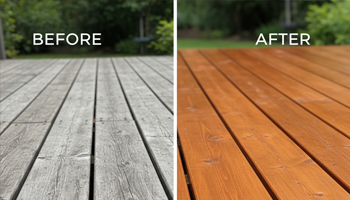
Repair Scratches in Hardwood Floors
How to Repair Scratches in Hardwood Floors: Complete Guide by Severity Level If you’re staring…
Refinishing Hardwood Floors
Sand & Refinish vs Screen & Recoat — Complete Comparison Guide If you’re weighing screen…
Polyurethane vs Oil Finish Floors
Durability & Maintenance Comparison If you’re comparing polyurethane vs oil finish for hardwood floors, you’re…
Best Hardwood Floor Cleaner
pH-Neutral & No-Residue Options TL;DR (buyer’s snapshot): For most homes, a pH-neutral hardwood floor cleaner…
Hardwood Floor Care Masterclass
Complete Guide by Wood Species & Finish If you want hardwood floor care by species…
Project Calculator: Choose Your Best Option
Enter your project details to compare chemical cost, mixing ratio, and a recommendation based on size, severity, and skill level.
FAQs
How to use oxalic acid on a weathered deck safely?
Mix 4–8 oz/gal warm water, apply evenly, keep wet 3–10 minutes, agitate lightly, and rinse thoroughly. Wear gloves, goggles, and a respirator for mists. Protect plants and redirect runoff.
Best concentration of oxalic acid for grey wood restoration?
Start 4 oz/gal for light/medium grey; 6–8 oz/gal for heavy. Always spot-test.
Commercial deck brightener vs pure oxalic—results?
Oxalic wins on deep grey and iron/tannin issues; commercial blends are close on light/medium grey and easier for beginners.
How long does oxalic acid wood brightening last?
Without a UV-blocking finish, the “fresh” look fades in weeks. Plan to stain within 24–72 hours after dry-down.
Can you restore extremely grey, weathered wood?
Yes—expect two passes (clean + brighten) and more agitation. Very degraded fibers may need light sanding before finishing.
Oxalic acid for cedar fence restoration?
Excellent choice—cedar responds beautifully at 4–6 oz/gal with a careful rinse.
Eco-friendly wood brightener alternatives to oxalic acid?
Citric-based brighteners offer milder handling; pair with gentle cleaning and thorough rinsing.
If you want maximum color restoration at the lowest chemical cost, pure oxalic—precisely mixed and thoroughly rinsed—wins most head-to-heads. If you value simplicity and safety for a smaller project, commercial brighteners shine. Either way, the rinse/neutralization step is non-negotiable if you want stain to bond and last.

